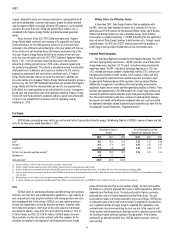Duke Energy 2012 Annual Report Download - page 29
Download and view the complete annual report
Please find page 29 of the 2012 Duke Energy annual report below. You can navigate through the pages in the report by either clicking on the pages listed below, or by using the keyword search tool below to find specific information within the annual report.
PART I
9
The current average sulfur content of coal purchased by USFE&G is
between 1% and 2% for the Carolinas; between 1% and 2% for Florida, and
between 2% and 3% for Indiana. USFE&G’s scrubbers, in combination with
the use of sulfur dioxide (SO2) emission allowances, enable USFE&G to satisfy
current SO2 emission limitations for its existing facilities.
Nuclear.
The industrial processes for producing nuclear generating fuel generally
involve the mining and milling of uranium ore to produce uranium concentrates,
the services to convert uranium concentrates to uranium hexafl uoride, the
services to enrich the uranium hexafl uoride, and the services to fabricate the
enriched uranium hexafl uoride into usable fuel assemblies.
USFE&G has contracted for uranium materials and services to fuel its
nuclear reactors in the Carolinas and Florida. Uranium concentrates, conversion
services and enrichment services are primarily met through a diversifi ed
portfolio of long-term supply contracts. The contracts are diversifi ed by
supplier, country of origin and pricing. USFE&G staggers its contracting so that
its portfolio of long-term contracts covers the majority of its fuel requirements
in the near-term and decreasing portions of its fuel requirements over time
thereafter. Near-term requirements not met by long-term supply contracts
have been and are expected to be fulfi lled with spot market purchases. Due to
the technical complexities of changing suppliers of fuel fabrication services,
USFE&G generally sources these services to a single domestic supplier on a
plant-by-plant basis using multi-year contracts.
USFE&G has entered into fuel contracts that, based on its current need
projections, cover 100% of its uranium concentrates, conversion services,
and enrichment services requirements through at least 2013 and cover
fabrication services requirements for these plants through at least 2018. The
cost of termination of nuclear fuel procurement contracts that Progress Energy
Florida has related to Crystal River Unit 3 are not expected to be material. For
subsequent years, a portion of its fuel requirements are covered by long-
term contracts. For future requirements not already covered under long-term
contracts, USFE&G believes it will be able to renew contracts as they expire, or
enter into similar contractual arrangements with other suppliers of nuclear fuel
materials and services.
Gas.
Oil and natural gas supply for USFE&G’s generation fl eet is purchased
under term and spot contracts from various suppliers. Duke Energy Carolinas
and Progress Energy Carolina’s use derivative instruments to limit their
exposure to price fl uctuations for natural gas. Progress Energy Florida uses
derivative instruments to limit its exposure to price fl uctuations for natural gas,
fuel oil and surcharges embedded in coal transportation agreements. USFE&G
has dual-fuel generating facilities that can operate with both fuel oil and
natural gas. The cost of USFE&G’s oil and natural gas is either at a fi xed price
or determined by market prices as reported in certain industry publications.
USFE&G believes that it has access to an adequate supply of oil and gas for
the reasonably foreseeable future. USFE&G’s natural gas transportation for
its gas generation is purchased under term fi rm transportation contracts with
interstate and intrastate pipelines. USFE&G may also purchase additional
shorter-term transportation for its load requirements during peak periods. Many
of the natural gas plants can be served by several supply zones and multiple
pipelines.
Purchased Power.
USFE&G purchased approximately 19.8 million MWh, 19.0 million
MWh and 18.3 million MWh of its system energy requirements during 2012,
2011, and 2010, respectively, under purchase obligations and leases and
had 4,500 MW of fi rm purchased capacity under contract during 2012. These
amounts include MWh for Progress Energy Carolinas and Progress Energy
Florida for all periods presented. These agreements include approximately
682 MW of fi rm capacity under contract by Progress Energy Florida with certain
QFs. USFE&G may need to acquire additional purchased power capacity in the
future to accommodate a portion of its system load needs. USFE&G believes
that it can obtain adequate purchased power to meet these needs. However,
during periods of high demand, the price and availability of purchased power
may be signifi cantly affected.
Gas for Retail Distribution.
USFE&G is responsible for the purchase and the subsequent delivery of
natural gas to native load customers in its Ohio and Kentucky service territories.
USFE&G’s natural gas procurement strategy is to buy fi rm natural gas
supplies (natural gas intended to be available at all times) and fi rm interstate
pipeline transportation capacity during the winter season (November through
March) and during the non-heating season (April through October) through a
combination of fi rm supply and transportation capacity along with spot supply
and interruptible transportation capacity. This strategy allows USFE&G to assure
reliable natural gas supply for its high priority (non-curtailable) fi rm customers
during peak winter conditions and provides USFE&G the fl exibility to reduce its
contract commitments if fi rm customers choose alternate gas suppliers under
USFE&G customer choice/gas transportation programs. In 2012, fi rm supply
purchase commitment agreements provided approximately 100% of the natural
gas supply. These fi rm supply agreements feature two levels of gas supply,
specifi cally (i) base load, which is a continuous supply to meet normal demand
requirements, and (ii) swing load, which is gas available on a daily basis to
accommodate changes in demand due primarily to changing weather conditions.
USFE&G also owns two underground caverns with a total storage capacity
of 16 million gallons of liquid propane. In addition, USFE&G has access to
5.5 million gallons of liquid propane storage and product loan through a
commercial services agreement with a third party. This liquid propane is used
in the three propane/air peak shaving plants located in Ohio and Kentucky.
Propane/air peak shaving plants vaporize the propane and mix it with natural
gas to supplement the natural gas supply during peak demand periods.
Duke Energy Ohio maintains natural gas procurement-price volatility
mitigation programs. These programs pre-arrange percentages of Duke Energy
Ohio’s seasonal gas requirements. Duke Energy Ohio uses primarily fi xed-price
forward contracts and contracts with a ceiling and fl oor on the price. As of
December 31, 2012, Duke Energy Ohio had locked in pricing for 22% of its
remaining estimated winter 2012/2013 system load requirements.
Inventory
Generation of electricity is capital-intensive. USFE&G must maintain an
adequate stock of fuel, materials and supplies in order to ensure continuous
operation of generating facilities and reliable delivery to customers. As of
December 31, 2012, the inventory balance for USFE&G was $2,987 million.
See Note 1 to the Consolidated Financial Statements, “Summary of Signifi cant
Accounting Policies,” for additional information.
Nuclear Insurance and Decommissioning
USFE&G owns (wholly or partially) 12 nuclear reactors located at seven
stations. Nuclear insurance includes: nuclear liability coverage; property,
decontamination and premature decommissioning coverage; and replacement
power expense coverage. The other joint owners of the jointly owned nuclear
reactors reimburse USFE&G for certain expenses associated with nuclear
insurance per the joint owner agreements. The Price-Anderson Act requires
nuclear plant owners to provide for public nuclear liability claims resulting
from nuclear incidents to the maximum total fi nancial protection liability, which
currently is $12.6 billion. See Note 5 to the Consolidated Financial Statements,
“Commitments and Contingencies — Nuclear Insurance,” for more information.
USFE&G has a signifi cant future fi nancial commitment to dispose of
spent nuclear fuel and decommission and decontaminate each plant safely. The
NCUC, FPSC and the PSCSC require USFE&G regulated utilities to update their
cost estimates for decommissioning their nuclear plants every fi ve years.
























